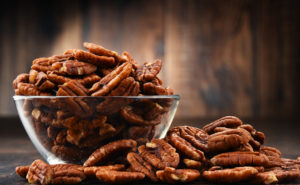Navigating Through Problems With Pecans | Natchitoches Pecans
Posted by wernuts2 on 1st Dec 2017
 There are very few sights as beautiful as a pecan orchard. Rows and rows of strong, beautiful trees against the great greens of the grass and the bright blue of the sky. A pecan orchard is a beautiful place to find peace in life’s most stressing moments, and the place where we make our life’s work to bring you the best pecans that nature has to offer.
There are very few sights as beautiful as a pecan orchard. Rows and rows of strong, beautiful trees against the great greens of the grass and the bright blue of the sky. A pecan orchard is a beautiful place to find peace in life’s most stressing moments, and the place where we make our life’s work to bring you the best pecans that nature has to offer.
Pecan trees are native to North America, so they not only belong here—they thrive here. They need the long, hot growing seasons of the southern most states to really produce beautiful and bountiful crops, which makes Louisiana a perfect pecan state. Though pecan trees are very hardy, there are certain things that can affect them, so we are especially diligent when it comes to: • Pollination. Unlike other flowering species, pecan trees do not rely on insects to pollinate; they rely on the power of the wind. The good news is that pecan tress produce both male and female flowers for this purpose; the bad news is, they blossom at different times meaning that one tree cannot pollenate its own flowers. For this reason, growers must plant trees that bloom at different times so that the male flowers of tree 1 open at the same time as the female flowers of tree 2 (and vice versa). This is why planning ahead is so important. • Fertilization. As hardy as pecan trees are, they need the right nutrients to survive and thrive. The best way to discover what a tree needs is to test the soil to see what is needed and provide accordingly. Zinc is one of the most important elements for a successful crop, and a deficiency can lead to abnormally small nuts, yellowing leaves, and early defoliation. • Leaffooted and Stink Bugs. These creatures love to feed on pecans as much as we do! They feed both before and after the shell hardens and this can cause dark spots to appear on the nut meats. These bugs love the hide in tall grasses and weeds, as well as dead autumn leaves, so keeping the orchard neat and tidy can eliminate their breeding and hiding spots. Weather can affect pecan trees in many ways, from too much rain to a sudden late frost. There is not much that can be done to prevent situations that arise from weather conditions, but we do our best to control what we can. Owning and operating a pecan orchard with family is a beautiful way to live, and we’ve been doing it for generations. From the planting to the final sale, our pecans are our life. For this reason, you can see why it’s so important that we take care of our trees and give them the best chance to grow strong so we can pass the bounty along to you.
